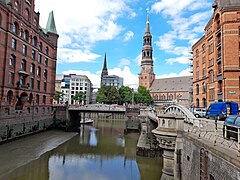
Back تغير المناخ والمدن Arabic Cambio climático y ciudades Spanish Mgbanwe ihu igwe na obodo ukwu IG 기후변화와 도시 Korean Климатски промени и градовите Macedonian 氣候變化與城市 Chinese

Climate change and cities are deeply connected. Cities are one of the greatest contributors and likely best opportunities for addressing climate change.[2] Cities are also one of the most vulnerable parts of the human society to the effects of climate change,[3] and likely one of the most important solutions for reducing the environmental impact of humans.[4][2][3] The UN projects that 68% of the world population will live in urban areas by 2050.[5] In the year 2016, 31 mega-cities reported having at least 10 million in their population, 8 of which surpassed 20 million people.[6] However, secondary cities - small to medium size cities (500,000 to 1 million) are rapidly increasing in number and are some of the fastest growing urbanizing areas in the world further contributing to climate change impacts.[7] Cities have a significant influence on construction and transportation—two of the key contributors to global warming emissions.[8] Moreover, because of processes that create climate conflict and climate refugees, city areas are expected to grow during the next several decades, stressing infrastructure and concentrating more impoverished peoples in cities.[9][10]

High density and urban heat island effect are examples of weather changes that impact cities due to climate change. It also causes exacerbating existing problems such as air pollution, water scarcity, and heat illness in metropolitan areas. Moreover, because most cities have been built on rivers or coastal areas, cities are frequently vulnerable to the subsequent effects of sea level rise, which cause flooding and erosion; these effects are also connected with other urban environmental problems, such as subsidence and aquifer depletion.
| Part of a series on |
| Climate change and society |
|---|
A report by the C40 Cities Climate Leadership Group described consumption based emissions as having significantly more impact than production-based emissions within cities. The report estimates that 85% of the emissions associated with goods within a city is generated outside of that city.[12] Climate change adaptation and mitigation investments in cities will be important in reducing the impacts of some of the largest contributors of greenhouse gas emissions: for example, increased density allows for redistribution of land use for agriculture and reforestation, improving transportation efficiencies, and greening construction (largely due to cement's outsized role in climate change and improvements in sustainable construction practices and weatherization).
- ^ "Climate change: the cities most at risk". The Week UK. 2 September 2021. Archived from the original on 19 October 2022. Retrieved 9 September 2022.
- ^ a b Zenghelis, Dimitri; Stern, Nicholas (19 November 2015). "Climate change and cities: a prime source of problems, yet key to a solution". The Guardian. ISSN 0261-3077. Archived from the original on 8 November 2020. Retrieved 11 November 2020.
- ^ a b "Cities: a 'cause of and solution to' climate change". UN News. 18 September 2019. Archived from the original on 4 March 2021. Retrieved 11 November 2020.
- ^ Liang, Longwu; Wang, Zhenbo; Li, Jiaxin (2019). "The effect of urbanization on environmental pollution in rapidly developing urban agglomerations". Journal of Cleaner Production. 237: 117649. Bibcode:2019JCPro.23717649L. doi:10.1016/j.jclepro.2019.117649. S2CID 200054369.
- ^ "68% of the world population projected to live in urban areas by 2050, says UN | UN DESA | United Nations Department of Economic and Social Affairs". www.un.org. Archived from the original on 10 March 2021. Retrieved 7 October 2021.
- ^ Sancino, Alessandro; Stafford, Max; Braga, Alessandro; Budd, Leslie (3 July 2022). "What can city leaders do for climate change? Insights from the C40 Cities Climate Leadership Group network". Regional Studies. 56 (7): 1224–1233. Bibcode:2022RegSt..56.1224S. doi:10.1080/00343404.2021.2005244. hdl:10281/458819. ISSN 0034-3404. S2CID 245371599.
- ^ United Nations (2018). "The World's Cities in 2018". population.un.org. Retrieved 19 May 2023.
- ^ Bazaz, Amir; Bertoldi, Paolo; Buckeridge, Marcos; Cartwright, Anton; de Coninck, Heleen; Engelbrecht, Francois; Jacob, Daniela; Hourcade, Jean-Charles; Klaus, Ian; de Kleijne, Kiane; Lwasa, Shauib; Markgraf, Claire; Newman, Peter; Revi, Aromar; Rogelj, Joeri; Schultz, Seth; Shindell, Drew; Singh, Chandni; Solecki, William; Steg, Linda; Waisman, Henri (2018). Summary for Urban Policymakers – What the IPCC Special Report on 1.5C Means for Cities. Indian Institute for Human Settlements (Report). doi:10.24943/scpm.2018. Archived from the original on 15 January 2023. Retrieved 11 November 2020.
- ^ "With people crowding into urban areas, how can cities protect themselves against climate change?". University of Helsinki. 14 May 2019. Archived from the original on 7 September 2020. Retrieved 11 November 2020.
- ^ Abrahams, Daniel (August 2020). "Conflict in abundance and peacebuilding in scarcity: Challenges and opportunities in addressing climate change and conflict". World Development. 132: 104998. doi:10.1016/j.worlddev.2020.104998. S2CID 218966713.
- ^ Henley, Jon (19 August 2022). "Hunger stones, wrecks and bones: Europe's drought brings past to surface". The Guardian. Retrieved 20 February 2023.
- ^ The Future of Urban Consumption in a 1.5 C World. C40 Cities Climate Leadership Group. June 2019. Archived from the original on 19 November 2020. Retrieved 11 November 2020.